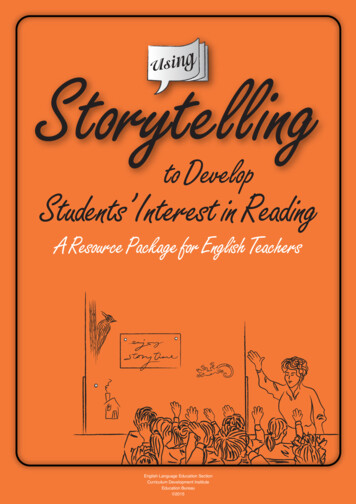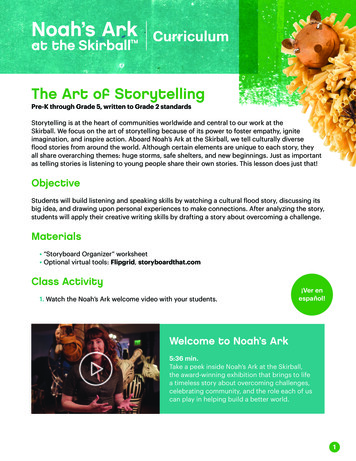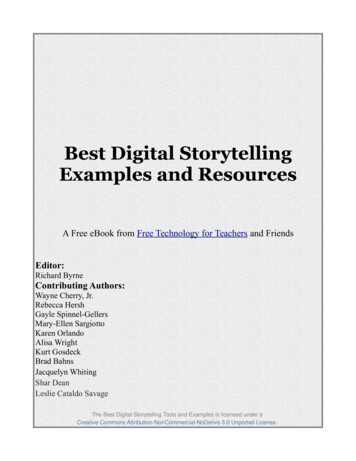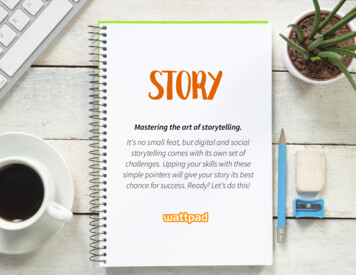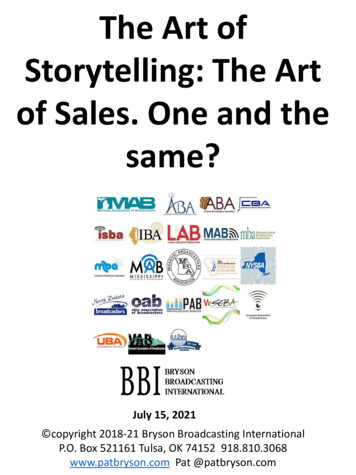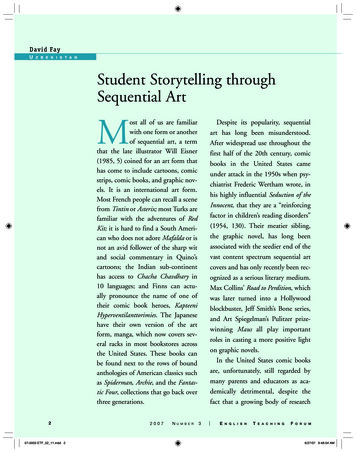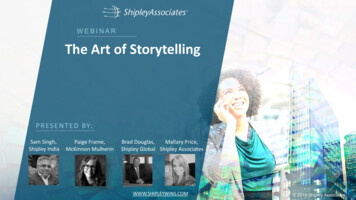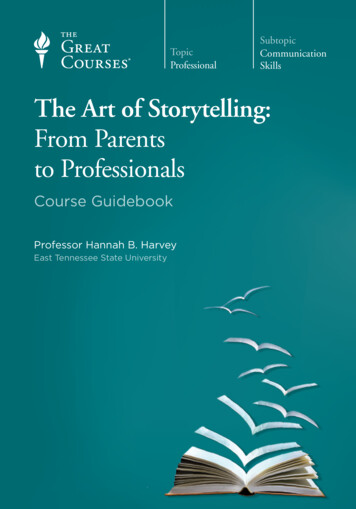
Transcription
TopicProfessionalSubtopicCommunicationSkillsThe Art of Storytelling:From Parentsto ProfessionalsCourse GuidebookProfessor Hannah B. HarveyEast Tennessee State University
PUBLISHED BY:THE GREAT COURSESCorporate Headquarters4840 Westfields Boulevard, Suite 500Chantilly, Virginia 20151-2299Phone: 1-800-832-2412Fax: 703-378-3819www.thegreatcourses.comCopyright The Teaching Company, 2013Printed in the United States of AmericaThis book is in copyright. All rights reserved.Without limiting the rights under copyright reserved above,no part of this publication may be reproduced, stored inor introduced into a retrieval system, or transmitted,in any form, or by any means(electronic, mechanical, photocopying, recording, or otherwise),without the prior written permission ofThe Teaching Company.
Hannah B. Harvey, Ph.D.Adjunct Professor, Storytelling ProgramEast Tennessee State UniversityProfessor Hannah B. Harvey is an AdjunctProfessor in the Storytelling programat East Tennessee State University, aninternationally recognized performer, and anationally known professional storyteller. Sheearned her Ph.D. in Communication Studies, witha concentration in Performance Studies, at The University of North Carolinaat Chapel Hill, where she was also a teaching fellow. She earned her B.A.from Furman University. Professor Harvey is the managing editor of thejournal Storytelling, Self, Society and a past president of Storytelling inHigher Education, the professional organization for scholars of storytellingwithin the National Storytelling Network. As a scholar-artist, she studiesstorytelling as a pervasive cultural force and an everyday artistic practice.Professor Harvey’s research and teaching specialty is performanceethnography, which unites theater with anthropology: Scholars investigateeveryday storytelling as an embodied cultural practice. As a performanceethnographer, she develops oral histories into theatrical and solo storytellingworks that highlight the true stories of contemporary Appalachian people.Her ongoing fieldwork with disabled coal miners in southwest Virginiaculminated in a live ethnographic performance of their oral histories, Outof the Dark: The Oral Histories of Appalachian Coal Miners, earning her adirecting award from adjudicators at the Kennedy Center American CollegeTheater Festival in 2007 and three year-end awards from professional criticsin 2005. Her written research has been honored by the American FolkloreSociety and featured in Storytelling, Self, Society, among other publications.Her research has been presented at the National Communication Association,the Oral History Association, the International Festival of University Theatre,and the Canadian Association on Gerontology.i
Professor Harvey is an award-winning director and performer and hasdelivered workshops in the United States, the United Kingdom, andMorocco. Her energetic style brings to life humorous and compellingstories from the worlds of personal experience, oral history, folklore, andmyth. Critics have called her work “very funny” (Theatre Guide London)and “deeply moving” (Classical Voice of North Carolina). As a solostoryteller, she has been featured at the National Storytelling Festival andin the International Storytelling Center’s Teller-in-Residence program.Her international performances as a member of the North Carolina–basedWordshed Productions earned a five-star review in the British TheatreGuide. Professor Harvey has led workshops in storytelling at the NationalStorytelling Festival in Tennessee; in the adaptation and performance ofliterature at the Edinburgh Festival Fringe in Scotland; and in cross-culturalstorytelling at University Hassan II, Ben M’Sik, in Casablanca, Morocco.Professor Harvey’s students at Kennesaw State University selected her asan Honors Program Distinguished Teacher and for the Alumni AssociationCommendation for Teaching Impact. She is proud of her Storytellingstudents’ achievements, from garnering professional credits (includinga four-star review from the British Theatre Guide for her students’ groupstorytelling adaptation of Beowulf) to simply enjoying and becoming morecritically aware of storytelling in their everyday lives. ii
Table of ContentsINTRODUCTIONProfessor Biography.iDisclaimer. viCourse Scope.1LECTURE GUIDESLecture 1Telling a Good Story 4Lecture 2The Storytelling Triangle 11Lecture 3Connecting with Your Story 17Lecture 4Connecting with Your Audience 24Lecture 5Telling Family Stories 31Lecture 6The Powerful Telling of Fairy Tales 38Lecture 7Myth and the Hero’s Journey 45Lecture 8Tensive Conflict and Meaning 52Lecture 9Giving Yourself Permission to Tell 60iii
Table of ContentsLecture 10Visualization and Memory 66Lecture 11Discovering Point of View 73Lecture 12The Artful Manipulation of Time and Focus 79Lecture 13Narrator—Bridging Characters and Audience 86Lecture 14Developing Complex Characters 93Lecture 15Plot and Story Structures 100Lecture 16Emotional Arc and Empathy 107Lecture 17Varying the Narrator’s Perspective 113Lecture 18Vocal Intonation 120Lecture 19Preparing to Perform 126Lecture 20Putting Performance Anxiety to Good Use 133Lecture 21Adapting to Different Audiences 139Lecture 22Invitation to the Audience—Mindset 146iv
Table of ContentsLecture 23Keeping Your Audience’s Attention 153Lecture 24Remember Your Stories—The Power of Orality 158Supplemental MaterialCredits 165Bibliography 166v
DisclaimerThis course includes stretching and breathing exercises for storytellers; youshould take into account your own level of physical fitness before performingthese exercises. Neither The Teaching Company nor Hannah Harvey isresponsible for your use of this educational material or its consequences.vi
The Art of Storytelling:From Parents to ProfessionalsScope:The gift of storytelling may be one of life’s most powerful—andenvied—skills. A story well told can make us laugh, weep, swell withpride, or rise with indignation. A story poorly told can be not onlyboring or uncomfortable but positively painful to experience. We all want totell good stories, but we don’t often realize how fundamental storytelling isto the human experience. Storytelling isn’t just entertainment; your story iswhat grounds you. It gives you a sense of purpose, identity, and continuitybetween the past and the present. This course takes both a practical and anintellectual approach to understanding how storytelling works and how touse artistic storytelling techniques to enhance your stories, big and small.Each lecture will help you build your repertoire of stories, often invitingyou to get up on your feet through guided workshops on specific aspects ofyour stories.Our introductory lecture looks at the nature and prevalence of “orality”in society today and helps us see how much of our lives are spent tellingstories. We’ll consider how your experience of telling and listening to anoral story is different than your experience of writing or reading a story.Telling does many things that writing simply can’t do, and it does thosethings quite powerfully for your audiences. The next three lectures helpus see storytelling as a relationship among the teller, the audience, and thestory. We look in-depth at these interconnected parts, beginning with yourrelationship with your story and the different ways we’re drawn to stories.You’ll discover some resources for finding different kinds of stories and whyit’s important to choose stories that matter to you personally. Perhaps mostimportant, we’ll look at the effect your relationship with your audience hason how, why, and even whether or not you tell your stories. This relationshipwith your audience is what sets storytelling apart from all other forms ofcommunication or entertainment. In all these interconnected relationships,there are a variety of contexts you must consider and establish: physical,emotional, intellectual, and social.1
We then move from “what is storytelling?” to “how and why are some storiesso powerful with audiences?” Having looked at what storytelling involvesfrom a broad view, we now look underneath the surface to question what oralstories do for us in our families (culturally), in our minds (psychologically),and in our human spirit.For some answers, we turn to three major genres of traditional stories. Oneof the first places we encounter stories is in our families, and these seeminglysmall stories are often the ones that stick with us, shape our sense of who weare, and get passed down to our children. When you lose a family member,that person exists primarily through stories. Family stories are as complex asfamily relationships are; often, we want to tell family stories to our friends, buthow do you bridge from inside the complex world of the family to the outsideworld? We’ll look at many examples of how to contextualize your familystories to connect them, playfully and powerfully, with the outside world.Family stories are an example of oral traditions, as are fairy tales. We oftenthink of fairy tales as simple children’s stories, but these lasting stories containcomplex themes (many of them sexual!) that help children and adults integrateand deal with the conflicting facets of human psychology. We look at howsome of these contradictory desires play out in the fantasy world of “Little RedRiding Hood” and how fairy tales can entertain both children and adults. Fairytales and myths often follow a trajectory of events that Joseph Campbell calledthe “hero’s journey.” The hero’s descent into the abyss and the battles that takeplace there with “the dragon” mirror the psychological battles we encounterin our own personal lives. The final lecture on traditional stories helps youidentify your own personal hero’s journey. We take a guided walk through oneof your stories, mapping your journey and identifying archetypal figures thatcan connect powerfully with your audiences.ScopeWith this foundation in what, how, and why, we turn to storytelling craftand technique.The workshop-based lectures begin by seeing the process of storydevelopment as a cycle of telling, writing, imaging, playing, and rehearsing.“Rehearsing” can be as simple or as involved as you wish for anygiven story; it involves stretching yourself, just as you would stretch anymuscle before you prepare to perform in a game. You may be surprised to2
find that you need to give yourself permission to stretch. You begin thisprocess by visualizing the world of your story, which is a particular way ofremembering a story that does not involve word-by-word memorization. Wethen consider multiple points of view in telling stories and the role of thenarrator as a guide who connects the audience with the other world of thestory. We investigate character development and kinesthetics, helping youfind humor, dimension, and playfulness with the people in your stories. Thestructure of your story is the container that holds these different elements—narrator, visualized events, and characters—and many different structuralforms are possible for stories. The emotional arc of your story—where yourstory goes emotionally—is a different thing than this structural trajectory ofevents; we’ll discuss how the two intertwine and influence your audiences.Your voice, along with your body, is a crucial instrument in your telling;you’ll practice warming up this instrument and building layers of intonationwith your stories. Because we all have some degree of nervous energy whenwe speak in public, we’ll also look at the mechanics of performance anxietyand how to channel nervous energy into an energized performance.We then turn to some specific issues you may face as a storyteller, withpractical advice for how to approach them. Through many examples, we’lllearn the best ways to address specific audiences, including children andorganizational audiences.Our final workshop lectures tie together the whole storytelling experienceby looking practically at introductions, conclusions, and everything inbetween—how to keep your audience’s attention through repetition,audience participation, and other elements of the craft of storytelling.We’ll conclude with a return to our initial observations, with new insightsinto the nature of orality and its continuing role, side by side, with the writtenword. Storytelling makes up the bulk of our daily lives. If every story has anarrator, whose perspectives influence the stories we hear and the stories thatinfluence our material decisions? What are the implications of our choicesas storytellers in creating meaning for our audiences and in the world?Storytelling is who we are and how we live our lives. This course aims tohelp you find even more humor, enjoyment, and fulfillment in the stories youtell as you discover your own voice as a storyteller. 3
Telling a Good StoryLecture 1Most of our lives are spent telling stories. Storytelling is at the coreof the human experience. Personal stories are what ground us—what give us a sense of purpose, identity, and continuity betweenthe past and the present. Oral storytelling is the primary way that peopleremember and record the peak moments of life in their families. In thiscourse, we will examine how you can tell stories better—that is, tell storiesin a way that brings them to life for other people, both within and outside ofyour family or your community.Lecture 1: Telling a Good StoryThe Study of Storytelling In academia, storytelling studies are found across a widevariety of programs—communications, theater, performancestudies, education—because storytelling directly taps into manydifferent fields. Our approach to storytelling in this course will take the perspectiveof a scholar-artist. We will not only learn practical guidelines forstorytelling, but we will also come to understand the nature of“story” and storytelling. By analyzing how storytelling works—how we use stories ineveryday life and why we tell stories—we can become betterpractitioners of storytelling as an art form.The Functions of Stories Written narratives are stories that we find in print, while oralnarratives—stories—live in conversation or in our memories. Theyare often not written down, but they come alive through our voicesand our bodies as we tell those stories. 4Stories serve multiple functions for us. For example, orally toldstories can delineate relationships and set parameters.
oIn my family, whenever we gather for a holiday, someone hasto make the “pink salad.” This salad is special to the cooksin my family because the recipe is a story that we share onlyinside the family.oIn other words, the recipe delineates borders between ourfamily and the outside world: the people who know the recipeand the people who don’t!oIt’s a small thing—a “story” about a salad—but it separates ourfamily and defines us as a cohesive unit.Stories also make life coherent; they give us a sense of who weare and where we’ve come from, and they give us a picture of thefuture that we can either work toward or avoid.o A story about my grandfather’s hands gives a sense of historyand the trajectory of his life. And it makes death bearablebecause in the story, death is not the end of my grandfather—he is still holding my hand. You may have people in yourlife who still hold your hand, too, whether or not they havepassed away.o When you’re telling someone a story, you’re doing more thanjust relaying a message; the story is a container for our deepestlongings, hopes, and fears.Stories also question life. Storytelling forces self-reflection: It putsup a mirror to yourself and to culture.o Your story gives you access to yourself; in other words, it’show you get a handle on yourself—if you don’t recognize yourstory, you can’t change it.oIn some sense, that’s what therapy does: It helps you shape anarrative for a listener, and in hearing yourself tell your ownstory and having someone question it for missing or forgottenparts, you can listen to and change your story.5
Stories reveal human truths, which are different from facts. Factsare what happened; truths are about what those events meantto people.o Many stories aren’t factual. A story about a gingerbread manwho runs away from home and gets eaten by a fox is completelyfictional, but it gives us a way to see a truth: how foolish it is torun away from the wisdom of people who love you for the sakeof having your own way.oSuch stories act on us, often invisibly. Many of the ideas wehave about what is truly important in life—ideas and valuesthat motivate decisions—come from stories.Lecture 1: Telling a Good StoryThe Focus of Storytelling Stories don’t live on the printed page but in spoken words andin images that we carry in our minds. The primary work of oralstorytelling is to convey the images in the mind of the teller to thelisteners. Storytelling is focused on image and storyline, not thememorization of written lines. Memorizing is the challenge of live theater. But storytelling is aboutknowing a series of images so well that they live in you so thatyou can call them back up, although not with the same words everytime. You don’t need to write down stories about your childhood;you know them by heart and can call them up at any time. Maybe you’re thinking, “But I don’t have any stories! My life isvery ordinary; nothing ever happens to me.” But as you hear storiesbeing told in this course, it’s likely that you will come up with manyideas for stories of your own. In future lectures, we’ll talk about thekind of journal keeping that storytellers use to develop their ideasinto stories.Outline of the Course We’ll start this course by looking at the basics of the storytellingprocess. It’s important to understand that storytelling is a livingcollaboration that involves the teller, the audience, and the story.6
The stories you tell are constantly adapted to each different audienceyou encounter; they aren’t delivered in one fixed, intact form. We’ll examine stories that have staying power. We’ll look at classicstories—from family stories to traditional fairy tales and myths—and explore why certain stories have lasted for so long, evenacross cultures. Throughout the course, we’ll also practice, using how-to workshopsthat will help you develop your stories, make them more engaging toyour audiences, and even make them more enjoyable for you to tell.“Hands” The story of my grandfather’s hands illustrates some of the qualitiesof oral storytelling. As we’ve said, storytelling is ephemeral. It’s also economical—nothing is wasted. “Hands” could have included many more details,but it was trimmed to focus on a few specific things. Stories are also “additive”; that is, they build on themselves. “Hands,” like other stories, contains certain oral memory aids, forexample, the repeated images of hands. These images unify thestory, but they also serve as a memory aid for the teller.o When we look at some of the earliest stories on record—those that come out of an oral culture—we see this samekind of redundancy. For example, we find repeated modifiersfor “Beowulf, son of Ecgtheow” in Beowulf or “Enkidu, thefaithful companion” in the Epic of Gilgamesh.o These repeated phrases highlight the fact that someone had toremember these stories.Also like an epic, “Hands” is action-centered. The story movesfrom planing wood, to working on engines, to building houses.Storytelling is focused on action and on agon (“struggle”).7
HandsOLecture 1: Telling a Good StoryWhen he was a little boy, mygrandfather [Tom Jr.] wouldfollow his father, Tom Sr.,out to his workshop, and hewould sit there and study hisfather while he worked. AndJunior, my grandfather, he’dgo tagging along behindhis father as his father wentup toward his shop. Hesaid, “I was taggin’ alongbehind, wonderin’ what hewas a’ gonna do.” On thisparticular day, Junior sat as his father took down this big old poplarboard—real dry wood. He always said, “Poplar works good, youknow; it’s good lumber.” And he got this board down and lookedat it, and laid it up on his workbench, and he started planing it, youknow. Junior just stared, that old wood of the shop, and freshly cutboards, and outside, the apple tree Tom Sr. had grafted. 8 Design Pics/Thinkstock.ne of the things I remember most about my grandfatherwas his hands. You see, my grandfather learned carpentryfrom his father. And by the time I knew him, his handswere tough, and those knuckles were just like big marbles set intohis fingers, they were so large. He used to come home from workwhen I’d come to visit, and take that big hand, and pat me on thehead with it—and when Iwas young, I didn’t thinkabout where those handshad been to make them soleathery and big.
And as he watched, he learned. And he used those young, stronghands to plane the boards himself. And when the war broke out, hetook those hands to Guam, and he used them to reach inside the bigengines of bomber planes that flew out over the Pacific. Those stronghands that held his bride so tightly when he came home, alive—alive!—from the war. And when he came home, those hands pickedup a hammer and wood, and they shook his father’s hand and thehands of young couples and preachers, because he and his father builthouses, and they built churches. He always said, “We don’t buildhomes; we build houses. You can’t build a home—you have to makea home. It takes a heap a’ living in a house to make it home.”Those hands, he washed and washed so that he could hold his babygirl, so small, her head fit right into the cup of his palm. And thenhis second baby girl—right there, nestled against his fingers. Handsthat held the rod and reel, the fish, the fork, and the belly. Hands thatplaned, like his daddy. Hands that held a walking stick for hours ashe continued to exercise after triple-bypass surgery. Held the walker,held the bedframe—held the tiny foot of his great-grandson; that footwas dwarfed by those big bones and marbled knuckles, covered insmooth skin. A hand that held mine—like he’d done all my life. Likehe still does, even though those hands are far away.You can tell a lot about a person, just by looking at their hands. Note, too, that those actions happened in a specific context. I didn’tsay that my grandfather went to war (an abstraction) but that heworked on a plane in Guam. Storytelling is central to the survival of the family and of specificpeople. Important people in our lives pass away, and what we haveleft of them are the stories we share.9
Suggested ReadingLangellier and Peterson, Storytelling in Daily Life.The National Storytelling Network, www.storynet.org.Ong, Orality and Literacy.Rydell, ed., A Beginner’s Guide to Storytelling.Questions to Consider1. How is your experience of telling and listening to an oral story differentthan your experience of writing or reading a story? What does telling dothat writing can’t do?2. What do you enjoy most about telling stories? What scares you mostLecture 1: Telling a Good Storyabout getting up to tell a story?10
The Storytelling TriangleLecture 2Storytelling isn’t about delivering a fixed thing. It’s a dynamic processof you shaping the story with the audience. One way of looking at theprocess of story crafting and storytelling is through the storytellingtriangle. In this lecture, we’ll set up the triangle, and in the followinglectures, we’ll look at two aspects of the triangle in more depth: developingyour relationship with the stories you tell and developing your relationshipwith your audience.The Points of the Triangle Telling a story is a three-way relationship involving you, the story,and the audience. We can represent this relationship with the imageof a triangle.Storytelling is a three-way relationship among the teller, the story, and theaudience, with each element of the triangle connected. Notice that none of the points on the triangle is independent of theothers—they’re all connected. Stories are always mediated througha storyteller and exist in relation to an audience.11
Again, storytelling is about connections; in fact, stories exist byvirtue of this connection with an audience and the teller.o If a story doesn’t grab you as a teller, chances are, it isn’t agood story for you to tell, because in order to tell a story well,you have to be connected to it. Even if you know a “good”story that others like, ask yourself: Is this a story that meanssomething to me?Lecture 2: The Storytelling Triangleo Storytelling is also about choices. There is no one “right” way totell a story because a story isn’t an “ideal form” that you are tryingto achieve; storytelling is a series of choices that you make in howto connect the audience with a story. Storytelling is an adaptive cultural phenomenon. Because of theseconnections among the story, audience, and teller, stories developand are adapted based on the needs and desires of the audience andthe teller. Many of the stories that we consider “canonized” as greattales, from Greek and Roman myths to fairy tales, exist becausethey connect with tellers and audiences.o Stories survive by virtue of their relationship with tellers andaudiences. In this sense, the very idea of what constitutesa story is culturally specific. For example, Western stories(those from the United States and Europe) typically focuson character development and a linear plotline; audiences inthese cultures tend to expect that the story will follow events asthey happened.o12You should also ask the same question for your audience: Is ita story your audience will connect with? You may have storiesthat are appropriate for only some audiences but not others,and if a story isn’t right for an audience, the connection won’tbe made.But in Bali and Java, there is no such expectation. A story maycenter on one event, then jump back in time, then move forward
The Old Maid Michael Blann/Photodisc/Thinkstock.Last time I saw myAunt Mae, we wentto the nursing home.I’d come home from college.I went with my mom, andwe walked in the door. Youknow how it is, kind of, insome nursing homes? Youopen that door and it smellsfaintly of rubbing alcohol andurine? We walked in—wewere going down the hall toher room, and as I passed bythis man in a wheelchair, he reached out and grabbed my shirt. Ikind of shied away from him, and I told my mom. She said, “Well,some people just don’t get a lot of visitors in here, and I bet he wasjust lonely.” I was really glad we were going to see my Aunt Mae.We walked in the door, and Days of our Lives was on, and she wason the phone with one of the women in her calling circle. She wasfinishing up that conversation, so we visited with her for about anhour. When it came time to leave, I bent down and I hugged her. Istood back up, I held her hand, and I remembered all those timeswhen I’d walked into her house. She had held my hand—big, tall,strong, big-boned. Now I was the tall one. She looked up at me andshe said very firmly, “Don’t forget about me.”I thought at the time that she just wanted me to come back and visit,but she passed away soon after that. “Don’t forget about me.”I keep a jar of Aunt Mae’s buttons on my desk, right beside a pictureof her. She’s got that big smile, all wrinkles. “Don’t forget aboutme.” She’s one of the most beautiful women I have ever known.13
years later. In these cultures and for these audiences, followinga linear timeline is not a requirement for a “real” story.Lecture 2: The Storytelling TriangleLines of Communication The three points of the storytelling triangle represent notonly connections but lines of communication—and not justone-way communication.14 Consider a situation in which you’re explaining the values of yourcompany to new employees. You might share a story with themabout the company. We could think of this situation as handing thestory over to the audience, as you would a briefing or a document.In a linear diagram, this would be represented with the story firstand then the teller, who takes the story to the audience. This picture is useful to see how stories are mediated by tellers.Every story we know—whether it’s an orally told story or one inprint form—was brought to us by storytellers. And the storyteller—the mediator—often has a stake in how
The art of Storytelling: From Parents to Professionals Scope: T he gift of storytelling may be one of life’s most powerful—and envied—skills. A story well told can make us laugh, weep, swell with pride, or rise with indignation. A story poorly told can be not only bori
